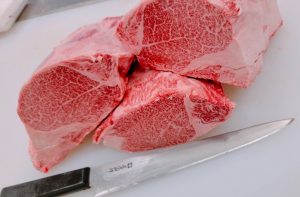

Today, let’s talk about the beef tenderloin—arguably the most prized cut of beef in the world.
Some people call it filet mignon, but technically that’s just one section of the tenderloin. For this article, I’ll stick with “tenderloin.”
It’s a cut almost everyone loves: lean yet incredibly tender, mild in flavor, and versatile in cooking. No other cut combines these traits quite like the tenderloin.
So let’s break it down: where it comes from, why it’s so tender, how it’s divided, and of course—why the famous chateaubriand sits at the very top of the beef world.
The tenderloin is a long, cylindrical muscle that runs along the inside of the backbone, beneath the strip loin (sirloin).
Because of its location on the interior side of the carcass, it doesn’t bear much weight or movement. That makes it unique compared to other cuts.
From a whole steer weighing about 1,000–1,200 lbs, the tenderloin only yields around 15–20 lbs of usable meat after trimming. That’s why it’s considered a rare and premium cut.
Tenderloin is famously soft and buttery—but why?
It’s all about muscle usage. Muscles that do more work (like the round or chuck) become tougher. But the tenderloin—also called the psoas major—is hardly used by the animal.
If cows walked upright on two legs like humans, the tenderloin would actually be much firmer. But since they walk on all fours, this muscle stays inactive, lean, and exceptionally tender.
Simple rule:
Although it’s one continuous muscle, chefs and butchers usually divide the tenderloin into three sections:
Each section has its own personality, and chefs choose based on how they plan to prepare it.
The chateaubriand is the jewel of the tenderloin. Taken from the thickest, center portion, it’s beautifully round, making it perfect for thick-cut steaks.
In American steakhouses, it’s often served as:
When sourced from USDA Prime beef or high-marbling breeds like Wagyu, the chateaubriand combines tenderness with buttery richness.
The only downside? The price. A chateaubriand steak is often 1.5–2x the cost of a strip loin steak. But many would say it’s worth every penny.
Fun fact: In butcher shops, handling tenderloin—especially the chateaubriand—is often reserved for senior butchers, because trimming it incorrectly can waste valuable meat. (I learned that lesson the hard way early in my career!)
Before it becomes the steaks you see at the butcher counter, a whole tenderloin must be carefully trimmed:
Done right, it transforms into the luxurious cuts we all know.
The classic method: a thick-cut steak, simply seasoned and seared. Because tenderloin is lean, it pairs beautifully with sauces like béarnaise, red wine reduction, or even a touch of truffle butter.
Other popular ways:
Whether grilled, roasted, or sliced thin for a quick sear, tenderloin delivers a truly premium eating experience.